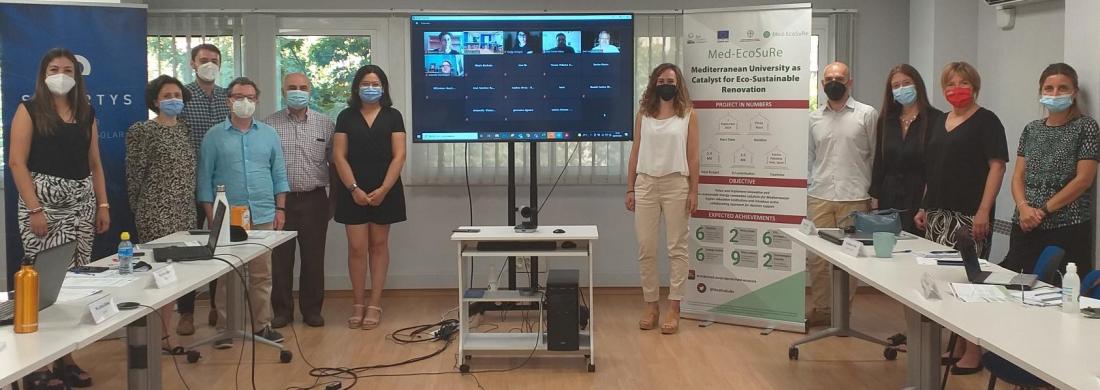MedEcoSuRe raises the curtain on a set of innovative solutions proposed for eco-sustainable building renovation in the Mediterranean

On the 20th of July 2021, the Solar Energy Cluster - SOLARTYS, in collaboration with University of Seville, organized an awareness raising event at SOLARTYS headquarters in Barcelona, to lay out the innovative technologies and solutions proposed in Med-EcoSuRe that will be adopted and implemented in the pilot university buildings with the aim to improve their energy performance.

In the framework of the Living Lab established, a number of renovation solutions have been proposed, by the project partners based on decision-support tools that include well-constructed models to address policy relevant issues with input from stakeholders, and which integrate social, economic and environmental factors.
Furthermore, following a survey launched in the framework of the project, a number of innovative technologies have been proposed by Spanish startups which were invited to the event, and shared their new applications and developed R&D products related with innovative solutions addressing energy retrofitting of universities' buildings.
This set of solutions and tools that were presented during the event included:
- Decision aid tool for Energy-Efficiency retrofit planning in Higher Education Buildings developed by the Thermothecnics Group at Thermal Energy Engineering Department at the University of Seville. This tool allows exploring several hundred thousand of renovation measures combinations, with the aim to identify the optimal one. The research team at University of Seville set a calculation method for the estimation of the energy savings of potential renovation measures, based on the building characterization parameters. Optimal cost procedures were proposed as well to investigate buildings in several climatic zones, and to calculate the measurement packages that allow the buildings to meet the standards of facilities with almost zero energy.
- Toolkit of Passive Solutions Design for Higher Education Buildings Retrofitting developed by the Department of Architecture at the University of Florence. The toolkit is an interactive, bottom up and participative programme of training and education on the energy retrofitting of the university building, with a list of suggestions for the management and sharing of experience. The development of this toolkit led to the identification of the optimal passive retrofit measures, and their replicability potential for higher education buildings in the Mediterranean area.
For more information about this toolkit check the following articles :
http://www.enicbcmed.eu/med-ecosure-shares-toolkit-retrofit-innovation-process
http://www.enicbcmed.eu/med-ecosure-makes-available-tool-support-retrofit-process-public-buildings
- Innovative Renewable Energy and Energy Efficiency technologies selected following a survey launched during the first phase of the project, which are the following:
1. PV for weak grids proposed by Trama TecnoAmbiental: a solar energy based electricity supply kit with energy storage system that can be installed in remote areas without grid or frequent grid interruptions. The company’s development of energy dispenser-meter does not only limit power but also energy, providing information for intelligent use of energy through automatic demand side management techniques. As a result, the electricity is consumed in an efficient manner and the lifetime of equipment (such as batteries) is increased.
2. Hybrid solar panels proposed by ENDEF: This system enables to produce heat & electricity in a single device based on proprietary core technology. The implementation of this solution will lead not only to visible improvements in the global efficiency in harvesting solar energy, but also into substantial cost savings and a second opportunity to thermal solar energy to be included in Nearly Zero emissions buildings, especially with heat pumps.
3. Smart Building automation systems proposed by Ingenium: A wired/wireless communication technology which enables the control of advanced automation applications such as lighting control, blinds control, climate control, IP cameras control, special lighting or audiovisual systems management. The higher penetration of automation will lead to increased device intelligence, and the smart buildings will serve as good examples of high levels of energy optimization, security, and communication to be applied in the university buildings.
4. Crystalline silicon photovoltaic glass proposed by SunSolutions: A Solar system to supply energy for lighting the buildings. This type of solar panels can be easily customized especially in term of shape since trapezoids can be fabricated without difficulty, and its efficiency can reach 16%.


By introducing the right support measures, properly addressing different building types and climates, and by increasing the awareness of all relevant stakeholders and the knowledge and skills of architects, designers, energy managers and the workforce in the construction sector, the approach proposed by MedEcoSuRe will be generic, and capitalized results would be scaled up for further public buildings concerns.









